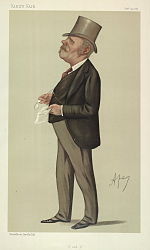Thomas Sutherland (banker)
| Sir Thomas Sutherland | |||||||||||||||||||||
|---|---|---|---|---|---|---|---|---|---|---|---|---|---|---|---|---|---|---|---|---|---|
 "P and O". Caricature by Ape published in Vanity Fair in 1887. | |||||||||||||||||||||
| Chinese | 蘇石蘭 | ||||||||||||||||||||
| |||||||||||||||||||||
Sir Thomas Sutherland, GCMG (Chinese: 蘇石蘭, 1834 – 1 January 1922) was a Scottish banker and politician, initially a Liberal Party then a Liberal Unionist. He founded The Hongkong and Shanghai Banking Corporation which was the founder member of HSBC Group and directed the P&O Company.
Sutherland was the son of Robert Sutherland of Aberdeen. Educated at Aberdeen University, he got his start clerking in the London office of the Peninsular and Oriental Steam Navigation Company (P&O). Soon after, P&O promoted Sutherland to superintendent, assigning him to Hong Kong to manage the firm's Asian operation.[1] In 1863 he became the first chairman of the Hong Kong and Whampoa Dock. In order to help finance the burgeoning trade between China and Europe, and explore the potential for China--United States trade, Sutherland established The Hongkong and Shanghai Banking Corporation in 1865[2] and became its first vice-chairman. He was appointed member of the Legislative Council of Hong Kong from 1865 to 1866. In 1872 he was appointed Managing Director of P & O.[3]
In November 1884, Sutherland was elected at a by-election as the Member of Parliament (MP) for Greenock.[4] A Liberal, he was re-elected in 1885, but when the Liberals split over Irish Home Rule he joined the breakaway Liberal Unionist Party. He was re-elected as a Liberal Unionist in 1886, but lost the seat at the 1892 general election. However, he was reinstated when his opponent was unseated on petition,[5] and held the seat until he stood down at the 1900 general election.[5]
Sutherland married Alice Macnaught in 1880, who predeceased him in 1920, as well by their two sons at the battlefield.[6] Sutherland died in London in 1922.
The Sutherland Street in Sheung Wan, Hong Kong was named after him.
References
- ^ Winn, Christopher (2012). I Never Knew That About the Scottish. Random House. ISBN 1407028936.
- ^ Finel-Honigman, Irene (2009). A Cultural History of Finance. Routledge. p. 116. ISBN 1135238510.
- ^ Debretts Guide to the House of Commons 1886
- ^ Craig, F. W. S. (1989) [1977]. British parliamentary election results 1832–1885 (2nd ed.). Chichester: Parliamentary Research Services. p. 548. ISBN 0-900178-26-4.
- ^ a b Craig, F. W. S. (1989) [1974]. British parliamentary election results 1885–1918 (2nd ed.). Chichester: Parliamentary Research Services. p. 510. ISBN 0-900178-27-2.
- ^ http://www.electricscotland.com/history/other/sutherland_thomas.htm
External links
- Hansard 1803–2005: contributions in Parliament by Sir Thomas Sutherland
- Electric Scotland – Sir Thomas Sutherland
- Use dmy dates from November 2012
- HSBC people
- Hutchison Whampoa
- Knights Grand Cross of the Order of St Michael and St George
- 1834 births
- 1922 deaths
- Scottish bankers
- Alumni of the University of Aberdeen
- Members of the Parliament of the United Kingdom for Scottish constituencies
- Politics of Inverclyde
- Scottish company founders
- Members of the Legislative Council of Hong Kong
- Scottish Liberal Party MPs
- UK MPs 1880–85
- UK MPs 1885–86
- Liberal Unionist Party MPs
- UK MPs 1886–92
- UK MPs 1892–95
- UK MPs 1895–1900
- Liberal MP for Scotland stubs
- British business biography stubs
